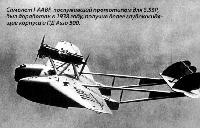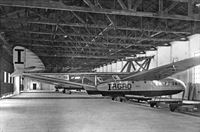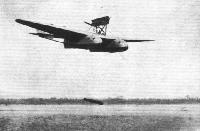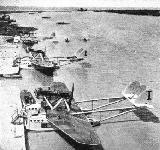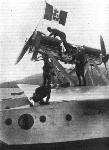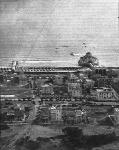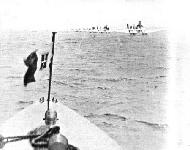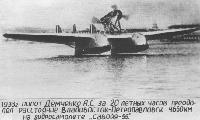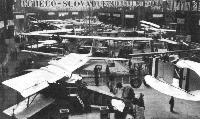
Описание
Страна : Италия
Год : 1924
Летающая лодка
Дальняя летающая лодка - разведчик/бомбардировщик
Варианты
- Savoia-Marchetti / SIAI - S.55 - 1924 - Италия
- Savoia-Marchetti / SIAI - S.63 - 1927 - Италия
- Savoia-Marchetti / SIAI - S.66 - 1931 - Италия
Savoia-Marchetti S.55
S.55 была одной из наиболее удачных летающих лодок, построенных в период между двумя мировыми войнами. Она была разработана по техническому заданию на новый многомоторный гидросамолет, бомбардировщик и торпедоносец.
Ее уникальными особенностями было использование корпуса-катамарана и толстого свободнонесущего крыла, в центральной секции которого располагалась кабина пилотов. Вертикальное хвостовое оперение состояло из двух килей и трех рулей направления, крепившихся на двух балках к крылу и хвостовым частям корпуса.
Первый прототип был оснащен двумя 300-сильными (224 кВт) ПД Fiat A.12bis, установленными тандемно над центропланом и приводившими тянущий и толкающий винты. Испытания, проведенные летом 1924 года, выявили недостаточную мощность силовой установки - максимальная скорость составляла всего 160 км/ч.
Характеристики второго прототипа, оснащенного парой ПД Lorraine 12Db по 400 л.с. (298 кВт), были немногим лучше, и руководство итальянских ВМС, и без того подозрительно относившееся к необычной схеме S.55, потеряло всякий интерес к самолету.
Однако компания "Savoia-Marchetti" считала, что новый самолет должен пользоваться успехом. Был разработан гражданский вариант S.55C, совершивший первый полет летом 1925 года, в каждом из корпусов которого были организованы места для пяти пассажиров.
Итальянское министерство авиации проявило запоздалый интерес к военному варианту самолета и в 1926 году заказало первую партию из 14 машин с двигателями Asso. В дальнейшем для перевооружения бомбардировочных эскадрилий морской авиации Италии было заказано большое количество S.55.
В 1930 году военные получили вариант с двигателями Fiat A.22R и корпусами новой формы, а вторая гражданская версия, S.55P, использовалась не только в Италии, но и в СССР и СШA.
Варианты
S.55: два прототипа и 88 военных самолетов первых серий, поставленных в 1927-1930 годах; в конечном итоге все оснащены двумя 510-сильными (380 кВт) ПД Isotta-Fraschini Asso 500, обеспечивающими максимальную скорость 190 км/ч
S.55C: первый гражданский вариант; восемь самолетов построены в 1925-1926 годах; большинство с ПД Lorraine, но позднее все оснащены ПД Asso 500
S.55P: второй гражданский вариант; 23 самолета поставлены в 1928-1932 годах; имели увеличенный корпус, вмещавший 10 пассажиров, и закрытую кабину экипажа; 14 машин использовались "Societa Aerea Mediterranea" на линиях, соединявших Рим, Неаполь, Сардинию и Сицилию; первоначально оснащались ПД Asso 500, затем Asso 500 Ri и, наконец, 700-сильными (522 кВт) ПД Fiat A.24R; три S.55P были проданы США; пять самолетов, проданных СССР в 1932 году, имели 880-сильные (656 кВт) ПД Asso 750 и усиленные корпуса
S.55A: обозначение 16 военных самолетов (A - от Atlantic), оснащенных 560-сильными (418 кВт) двигателями Fiat A.22R
S.55M: семь машин с двигателями Asso 500Ri, построенных "Piaggio" в 1930 году; деревянная конструкция по большей части заменена металлом
S.55 Scafo Allargato (увеличенный корпус): аналогично S.55A, но с более широкими и глубокими корпусами и закрытой кабиной экипажа; "Savoia-Marchetti" построила 16 машин, восемь с ПД Asso 500 и восемь с Asso 500Ri, a CANT построила восемь подобных и столько же S.55 Scafo Ailargatissimo (сильно увеличенный корпус) с еще более увеличенными обтекаемыми корпусами; "Savoia Marchetti" построила в 1932-1933 годах 20 самолетов с ПД Fiat A.22R, в 1933 году "Macchi" изготовила 16 самолетов, a CANT - шесть, все с ПД Isotta-Fraschini Asso 500Ri; все эти машины поступили в итальянские части
S.55X: 25 самолетов с ПД Asso 750, поставлены в 1933 году для перелета через Северную Атлантику; по возвращении в Италию получили вооружение и использовались как разведчики/бомбардировщики в 31-м и 35-м полках до замены на CANT Z.506B в 1938 году; три машины недолгое время использовались испанскими националистами в начале гражданской войны. Часть военных S.55 с модифицированным корпусом и двигателями Asso 750 иногда называли S.55X, а их собратья без этих двигателей обозначались S.55N
ТАКТИКО-ТЕХНИЧЕСКИЕ ХАРАКТЕРИСТИКИ
Savoia-Marchetti S.55X
Тип: дальняя летающая лодка - разведчик/бомбардировщик
Силовая установка: два рядных ПД Isotta-Fraschini Asso 750 мощностью по ! 880 л. с. (656 кВт)
Летные характеристики: максимальная скорость 279 км/ч; потолок 5000 м; дальность полета 3500 км
Масса: пустого снаряженного 5750 кг; максимальная взлетная 8260 кг
Размеры: размах крыла 24,00 м; длина 16,75 м; высота 5,00 м; площадь крыла 93,00 м2
Вооружение: четыре 7,7-мм пулемета и одна торпеда или до 2000 кг бомб
Описание:
- Savoia-Marchetti S.55
- Flight, April 1925
THREE "SAVOIA" SEAPLANES
Фотографии
-
История Авиации 2000-05 / В.Котельников - Истроия пяти "Савой" /Между войнами/
C-55 в Севастополе на контрольных испытаних, проводимых НИИ ГВФ. Лето 1933г.
-
История Авиации 2000-05 / В.Котельников - Истроия пяти "Савой" /Между войнами/
Регистрационный номер: СССР-Л997 [2] C-55 из состава 13-го транспортного авиаотряда. Дальний Восток, лето 1935г.
-
Air Enthusiast 1971-06 / ??? - Oil well top cover: Sixty years of Rumanian military aviation
Savoia-Marchetti S.M.55 of the Naval Flotilla, Constanza, 1934.
-
Мировая Авиация 230
Этот S.55SA из 1-й гидроэскадрильи ВВС Румынии в 1930-х годах базировался в Констанце.
-
Aviation Historian 32 / M.Wickstead - Italy's forgotten airlines (2)
Регистрационный номер: I-AABF [4] SIAI-Marchetti S.55 flying-boat I-AABF (c/n 97), thought to be the S.55P prototype (with deeper hulls faired into the upper surface of the wing), joined the SAM fleet in June 1928. It was used predominantly on the Rome - Cagliari service, as marked on the forward section of the port hull in this rare flying shot of a SAM S.55R. This machine was withdrawn from use in 1933.
-
Мировая Авиация 230
Регистрационный номер: I-AABF [4] Август 1924г.: Savoia Marchetti S.55, вероятно, самая удачная межвоенная летающая лодка, применявшаяся по всему миру до конца 1930-х годов.
Самолет I-AABF, послуживший прототипом для S.55P, был доработан в 1938 году, получив более глубокосидящие корпуса и ПД Asso 500. -
Мировая Авиация 98
Регистрационный номер: I-AABF [4] 6 января 1931г.: итальянский генерал Итало Бальбо во главе группы из 12 военных летающих лодок Savoia-Marchetti S.55 выполнил первый групповой перелет через Южную Атлантику между Португальской Гвинеей и Наталем в Бразилии.
Летающие лодки и гидропланы итальянской фирмы SIAI пользовались неплохим спросом в 30-х гг. И потому подобные рекламные снимки не сходили со страниц авиационных журналов мира. -
Aviation Historian 31 / M.Wickstead - Italy's forgotten airlines (1)
Регистрационный номер: I-ABOR [2] Bearing the legend “Aero Espresso Italiana” on the outer sides of its distinctive twin hulls, Savoia-Marchetti S.55C I-ABOR awaits its next flight. The machine joined the AEI fleet in August 1925, but had a short career, being lost in a crash crossing the Sea of Marmara on a service to Constantinople in September 1927.
-
Aeroplane Monthly 1989-01 / J.Stroud - Wings of Peace
Регистрационный номер: I-ABOR [2] I-ABOR, the prototype S.55C, in Aero Espresso livery.
-
Aviation Historian 31 / M.Wickstead - Italy's forgotten airlines (1)
Регистрационный номер: I-AGRO Minus its tandem Isotta-Fraschini Asso 500 engines on the central pylon, S.55C I-AGRO (c/n 10505) undergoes maintenance at AEI’s workshops in Brindisi. This example, one of the five operated by AEI, fared slightly better than I-ABOR, serving the airline for eight years from March 1926 until its demise in a crash in August 1934.
-
Aeroplane Monthly 1989-01 / J.Stroud - Wings of Peace
Регистрационный номер: I-NDRA The S.55P I-NDRA after passing to Ala Littoria ownership. The airline's flag is painted on the bows.
-
Aeroplane Monthly 1989-01 / J.Stroud - Wings of Peace
Регистрационный номер: I-AABF [4] I-AABF, the first S.55P, with Societa Aerea Mediterranea painted on the hull beneath the portholes. Forward of the open hatch are the words Roma-Cagliari.
-
Aeroplane Monthly 1989-01 / J.Stroud - Wings of Peace
Регистрационный номер: NC20K [2] NC20K, the S.55P used by Alaska Airways, at Golden Gardens, Elliott Bay, Seattle, in July 1937.
-
Air Enthusiast 1996-09 / M.Axworthy - Flank Guard. Romania's Aerial Advance on Stalingrad (2)
Romania received eight SM.55 flying-boats (I to VIII) for ‘Escadrila’ 102 over 1933-1936, the last of which was withdrawn in 1943. Although fitted to carry torpedoes, Romania seems only to have armed them with bombs.
-
Jane's All the World Aircraft 1980 / Encyclopedia of Aviation - 1. Chronology
Savoia-Marchetti flying-boats (1-15 July 1933).
-
Flight 1925-04 / Flight
The Savoia S.55 twin-boat mono-seaplane in flight, launching its torpedo.
-
Flight 1925-04 / Flight
Three-quarter front view of the Savoia S.55 torpedo and mine-laying mono-seaplane with twin boats and tandem engines (400 h.p. Lorraine-Dietrich).
-
Flight 1927-06 / Flight
PINEDO'S BIG FLIGHT: The Savoia S.55 mono-seaplane, fitted with two 500 h.p. Isotta-Fraschini engines.
-
Flight 1940-06 / Flight
Savoia-Marchetti S.55
-
Flight 1930-12 / Flight
THE ITALIAN SQUADRON'S ATLANTIC FLIGHT: As reported below the twelve Italian Savoia S.55 flying-boats left Orbetello, under the leadership of Gen. Balbo, on December 17. The above picture shows one of the flying-boats being "tractored" to the water.
-
Flight 1933-09 / Flight
Italian flying-boats, Savoia S.55 class, a commercial version the type used by Gen. Balbo on his Atlantic flights.
-
АвиаМастер 2007-03 / А.Харук - Средиземноморская чайка: Гидросамолет Cant Z.501 /Монография/
Летающие лодки "Кант" Z.501 и SM.55 на гидроавиабазе в Триесте.
Другие самолёты на фотографии: CANT Z.501 Gabbiano - Италия - 1934
-
Flight 1930-12 / Flight
THE ITALIAN SQUADRON'S ATLANTIC FLIGHT: A final inspection being made before the start of the two Fiat A22R engines in one of the boats.
-
Aeroplane Monthly 1989-01 / J.Stroud - Wings of Peace
Регистрационный номер: NC20K [2] The tandem Asso 500 engines and two-bladed wooden propellers of S.55P NC20K.
-
Aviation Historian 2 / J.de Uphaugh - Lord of the Distances
The original Santa Maria under tow at an American port before its later destruction at Roosevelt Dam. The Marquis is standing on the stern of the boat. Note the fasces painted on the twin hulls.
-
Air-Britain Archive 1981-03
Savoia Marchetti SM.55 "Santa Maria" preparing to dock.
-
Flight 1931-01 / Flight
AVANTI SAVOIA!: One of the Savoia S.55 flying-boats which carried out the successful formation flight across the Atlantic from Africa to Brazil. The decorations were not flown during the crossing
-
Aviation Historian 2 / J.de Uphaugh - Lord of the Distances
Spectators gather around Santa Maria II, the second of the SM.55s used on de Pinedo’s tour of the Americas in 1927, after the loss of the original Santa Maria in Arizona on April 6.
-
Flight 1927-07 / Flight
PINEDO ARRIVES HOME: A snapshot, taken from one of the escorting seaplanes, of the Marchesse de Pinedo landing in the "Santa Maria II" at Ostia, near Rome, on June 16, at the conclusion of his wonderful flight, Italy-America-Italy.
-
Мировая Авиация 9
Регистрационный номер: I-BALB, I-BISE, I-QUES 15 июля 1933г.: группа из 24 итальянских гидросамолетов под командованием генерала Итало Бальбо выполнила посадку на озере Мичиган. Группа покинула Италию 1 июля, Атлантику самолеты пересекли в несколько приемов. Летчики вернулись в Италию 12 августа. Самолеты выполнили не просто дальний перелет, а перелет в составе группы из большого количества самолетов.
-
Flight 1933-08 / Flight
HOME AGAIN: Some of the Italian flying boats circling over Rome before alighting.
-
Flight 1933-08 / Flight
The Armada arrives at New York, July 19; note the U.S. airship Macon in the background.
-
Aviation Historian 2 / J.de Uphaugh - Lord of the Distances
The SM.55 was designed by Alessandro Marchetti, who joined SIAI to establish Savoia-Marchetti in 1922, and who incorporated a number of unusual features in the design of the flying-boat, including its distinctive double hull and its tandem engines which drove counter-rotating propellers.
-
Flight 1933-08 / Flight
Balbo's "Aerial Armada" at their buoys in the St. Lawrence River, Montreal, on their arrival, July 14.
-
Flight 1933-07 / Flight
AFLOAT: The Italian Wing before the Start.
-
Aviation Historian 37 / U.Vicenzi - Aces High
Still looking like something from science-fiction today, the S.55X incorporated twin hulls on a thick-section wing, powered by a pair of Asso 750 powerplants mounted above the cockpit in the wing’s centre-section.
Inset: Another glorious Futurist poster celebrating Balbo’s Decennial transatlantic cruise to the USA in 1933. Bal bo was determined that Italy should be perceived as a technologically advanced nation, and saw the USA as a natural ally in his desire to extol the virtues - political and military - of aviation. -
Flight 1933-07 / Flight
THE POWER: The mounting of the two "Isotta-Fraschini asso 750" engines.
-
Aviation Historian 37 / U.Vicenzi - Aces High
The S.55X was the only variant of the type to be powered by the Asso 750, as seen here in its distinctive configuration with a tractor engine at the front of the nacelle and a pusher at the rear, the propellers counter-rotating. Note the upward-pointing thrust-line of the nacelle, and the port wire-braced boom supporting the triple-finned tail.
-
Авиация и Космонавтика 2011-08 / Гражданская авиация Камчатки /Фотоархив/
1933г. пилот Демченко А.С. за 20 летных часов преодолел расстояние Владивосток - Петропавловск 4560 км на гидросамолете "Савойя-55"
-
История Авиации 2000-05 / В.Котельников - Истроия пяти "Савой" /Между войнами/
C-55 в Севастополе на контрольных испытаних, проводимых НИИ ГВФ. Лето 1933г.
-
История Авиации 2000-05 / В.Котельников - Истроия пяти "Савой" /Между войнами/
Регистрационный номер: СССР-Л997 [2] Летающая лодка S.55 (СССР-Л997), работавшая на линии Хабаровск-Петропавловск-Камчатский, у берега Тихого океана. Лето 1936г.
-
История Авиации 2000-05 / В.Котельников - Истроия пяти "Савой" /Между войнами/
Самолеты - главная мечта советских мальчишек в 30-х гг. Одна из советских S.55 на Дальнем Востоке.
-
Flight 1930-05 / Flight
AT MILAN AERO SHOW: The combined exhibit of Isotta Fraschini, S.I.S.A. (the Savoia 55 flying-boat), and S.A.M. Air Lines.
-
Flight 1928-07 / Flight
IN THE GRAND PALAIS: View looking South. In the foreground the Aero cabin biplane, as used on Czechoslovak air lines. Beyond, the CAMS flying-boat. On the right, the tail of the twin-hull Savoia S.55.
Другие самолёты на фотографии: Aero A.23 / A.38 - Чехословакия - 1926CAMS CAMS 51 / CAMS 53 / CAMS 56 - Франция - 1926
-
Flight 1931-01 / Flight
The pilot's cabin and dash of the S.55. British instruments, supplied by "Smith's," were used on all the machines.
-
Flight 1931-01 / Flight
The wireless cabin of the Savoia S.55 flying-boat. Wireless played an important part throughout the flight.
-
Aviation Historian 40
TAH author Ugo Vicenzi’s 3D computer modelling two precise externally-accurate replicas of Isotta Fraschini Asso 750 engines to be machined from urethane resin by Northern Italy-based firm Plyform Composites for the Savoia Marchetti Historical Group’s S.55X flying-boat replica. They are seen here with Plyform’s Gabriele Caccia.
-
Aviation Historian 37 / U.Vicenzi - Aces High
A classic contemporary Italian poster celebrating Italo Balbo’s Crociera Aerea Del Decenniale (Decennial Aerial Cruise marking ten years since the formation of the Regia Aeronautica). He led 24 twin-Asso 750-powered SIAI-Marchetti S.55Xs in formation from Italy across the Atlantic to the Chicago World’s Fair in the USA during July-August 1933.
-
Flight 1925-04 / Flight
Savoia S.55 Torpedo Seaplane Two 400 hp Lorraine-Dietrich Engines
- Фотографии





